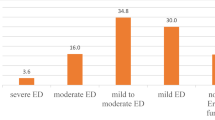Abstract
Introduction
Residual renal function and erectile dysfunction are important parameters of quality of life in dialysis patients.
Goal
The purpose of our investigation was to determine correlations between erectile dysfunction and residual diuresis in patients on hemodialysis.
Methods
The survey was organized as a cross-sectional study in men aged up to 65 years on hemodialysis. All respondents voluntarily completed the questionnaire of the International Index of Erectile Function (IIEF)-5. Demographic and anthropometric characteristics, the duration of dialysis, smoking, alcohol consumption, residual renal function, comorbidity, and routine biochemical parameters were determined for all patients. The adequacy of dialysis was calculated as Kt/V. Based on residual renal function, the patients were divided into a group without residual diuresis and a group with preserved residual renal function.
Results
Nearly two-thirds of our patients did not have preserved diuresis, while 82.8% of our respondents had erectile dysfunction. Patients with preserved residual renal function were heavier (P = 0.047) and had higher body mass index (P = 0.047), but the prevalence of cardiovascular disease (P < 0.0001) and erectile dysfunction (P < 0.0015) was lower, compared to patients without residual diuresis. The regression model also demonstrated a statistically significant relationship between the residual diuresis and the total IIEF score (b = 4.74; P < 0.001).
Conclusion
Hemodialysis patients with preserved diuresis retain erectile function better.
Similar content being viewed by others
References
Yilmaz A, Goker C, Kocak OM (2009) Sexual functioning in hemodialysis patients and their spouses: results of a prospective study from Turkey. Turk J Med Sci 39:405–414
Wespes E, Amar E, Hatzichristou D (2006) EAU guidelines on erectile dysfunction: an update. Eur Urol 49:806–815
Palmer BF (1999) Sexual dysfunction in uremia. J Am Soc Nephrol 10:1381–1388
Derby CA, Araujo AB, Johannes CB, Feldman HA, McKinlay JB (2000) Measurement of erectile dysfunction in population-based studies: the use of a single question self-assessment in the Massachusetts male aging study. Int J Impot Res 12:197–204
Lin BY-F, Wu V-C, Ko W-J (2009) Residual urine output and postoperative mortality in maintenance hemodialysis patients. Am J Crit Care 18:446–455
Lameire N, Biesen WV, Vanholder R (2002) Initiation of dialysis—is the problem solved by NECOSAD? Nephrol Dial Transplant 17:1550–1552
Vilar E, Wellsted D, Chandna SM, Greenwood RN, Farrington K (2009) Residual renal function improves outcome in incremental haemodialysis despite reduced dialysis dose. Nephrol Dial Transplant 24:2502–2510
Rhoden EL, Telöken C, Sogari PR, Vargas Souto CA (2002) The use of the simplified international index of erectile function (IIEF-5) as a diagnostic tool to study the prevalence of erectile dysfunction. Int J Impot Res 14:245–250
Rosen RC, Cappelleri JC, Gendrano N (2002) The International Index of Erectile Function (IIEF): a state-of-the-science review. Int J Impot Res 14:226–244
Kooman J, Basci A, Pizzarelli F et al (2007) EBPG guideline on haemodynamic instability. Nephrol Dial Transplant 22(2):22–44
Horinek A, Misra M (2004) Does residual renal function decline more rapidly in hemodialysis than in peritoneal dialysis? How good is the evidence? Adv Perit Dial 20:137–140
Shankar A, Leng C, Chia KS et al (2008) Association between body mass index and chronic kidney disease in men and women: population-based study of Malay adults in Singapore. Nephrol Dial Transplant 23:1910–1918
Hsu C, McCulloch CE, Iribarren C et al (2006) Body mass index and risk for end-stage renal disease. Ann Intern Med 144:21–28
Djukanovic LJ (2010) Obesity and chronic kidney disease: In Stolic R (ed) Comorbidity of obesity and some selected chapters, K.Mitrovica (Serbian)
Stolic R (2010) Obesity in renal failure-health or disease? Med Hypotheses 75:497–500
Beckman TJ, Abu-Lebdeh HS, Mynderse LA (2006) Evaluation and medical management of erectile dysfunction. Mayo Clin Proc 81:385–390
Stolic RV, Bukumiric ZM (2010) Intima-media thickness of carotid arteries and erectile dysfunction in hemodialysis patients. Hemodial Int 14:510–514
Bank AJ, Billups KL, Kaiser DR (2003) Relation of C-reactive protein and other cardiovascular risk factors to penile vascular disease in men with erectile dysfunction. Int J Impot Res 15:231–236
Wan AYM, Lai K-N (2006) The importance of residual renal function in dialysis patients. Kidney Int 69:1726–1732
Roszkowska–Blaim M, Skrzypczyk P, Drozdz D, Pietrzyk JA (2009) Residual renal function in children treated with continuous ambulatory peritoneal dialysis or automated peritoneal dialysis—A preliminary study. Adv Perit Dial 25:103–109
Rosas SE, Joffe M, Franklin E, Franklin E, Strom BL, Kotzker W, Brensinger C, Grossman E, Glasser D, Feldman HI et al (2001) Prevalence and determinants of erectile dysfunction in hemodialysis patients. Kidney Int 59:2259–2266
Moist LM, Port FK, Orzol SM et al (2000) Predictors of loss of residual renal function among new dialysis patients. J Am Soc Nephrol 11:556–564
Haag-Weber M (2008) The impact of residual diuresis on survival. Nephrol Dial Transplant 0:1–3
Szeto CC, Chow KM (2007) Residual renal function and recovery of renal function. Perit Dial Int 27:159–161
Köhler TS, McVary KT (2009) The relationship between erectile dysfunction and lower urinary tract symptoms and the role of phosphodiesterase type 5 inhibitors. Eur Urol 55:38–48
Author information
Authors and Affiliations
Corresponding author
Rights and permissions
About this article
Cite this article
Stolic, R.V., Bukumiric, Z.M., Jovanovic, A.N. et al. Residual renal function and erectile dysfunction in patients on hemodialysis. Int Urol Nephrol 44, 891–895 (2012). https://doi.org/10.1007/s11255-011-9931-z
Received:
Accepted:
Published:
Issue Date:
DOI: https://doi.org/10.1007/s11255-011-9931-z




